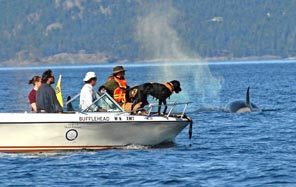forum
library
tutorial
contact

With Dog's Help, Clues to Orcas' Decline
Found in Whale Scat
by Lynda V. MapesSeattle Times, November 19, 2008
|
the film forum library tutorial contact |

|
With Dog's Help, Clues to Orcas' Decline
by Lynda V. Mapes |
 Researchers trying to learn whether orcas are starving have turned - with the help of a dog - to a new source of information: orca scat.
Researchers trying to learn whether orcas are starving have turned - with the help of a dog - to a new source of information: orca scat.
Tucker, a black Lab trained in tracking animal scat, has been deployed two of the past three summers to track down orca scat between the San Juan Islands and Vancouver Island in Haro Strait, sniffing his quarry from the bow of a research boat for a University of Washington research team.
When Tucker finds what researchers are looking for, he gets to play with his ball. So he is a highly motivated tracker - and in the summers of 2006 and 2008, he helped track down some of 130 samples of scat from orca whales in Puget Sound's J, K and L pods.
Sam Wasser, director of the UW's Center for Conservation Biology, led the research team, which analyzed hormone levels in the scat. What they found surprised them. The orca mortality rate was the highest when thyroid hormone levels were lowest, indicating the animals may be nutritionally deprived.
The southern resident population of orcas that frequents Puget Sound is endangered. The seven orcas missing and presumed dead this year bring the population to just 83 animals, the fewest since 2003, and down from a recent high of 97 in 1996. The number of deaths has alarmed researchers, who haven't seen as steep a drop in nearly a decade.
The hormone study has not yet been published or peer-reviewed, and researchers want to get more data. But they think their preliminary findings may be an important clue to the orcas' decline.
"I'm pretty confident that what we are seeing is nutritional deficit," said Katherine Ayres, a UW graduate student working on the study. "It is interesting and sad. We have a link to what scientists have been saying for a long time."
Another regional icon, Puget Sound chinook salmon, were listed as a threatened species nearly 10 years ago. Both species are plagued by a range of ills, and no one solution will help bring them back. Addressing the food web that orcas depend on will involve not only rebuilding salmon populations, but also the species that salmon depend on, such as herring.
The orcas also need to be able to find their food, which could require restrictions on vessel traffic, so underwater noise doesn't interfere with their echolocation, a kind of sonar orcas rely on.
Orcas are wide-ranging, too, so salmon runs need to be robust not only here in Washington but in Canada's Fraser River, where many of the salmon runs that orcas feed on in the summer originate.
They also travel as far south as California in the winter, and may depend on salmon returning to the Sacramento and Columbia rivers, too.
"We really have to take a broader look," said Fred Fellerman, a consultant for Friends of the Earth, an environmental group. "We can't just say save the whales, we have to save the chinook, and the food for the chinook. Otherwise we are really fooling ourselves that we can save the Sound."
learn more on topics covered in the film
see the video
read the script
learn the songs
discussion forum
